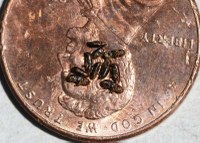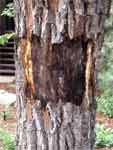New threat
The tiny beetles — drop one on a penny and it’s about the size of Abe Lincoln’s eyebrow —  eat their way to the inner bark of black walnut trees. Then a nasty sounding pathogen they carry, the “thousand canker fungus,” wrecks tissues the tree uses to move nutrients through its system. eat their way to the inner bark of black walnut trees. Then a nasty sounding pathogen they carry, the “thousand canker fungus,” wrecks tissues the tree uses to move nutrients through its system. 
Origin
The beetles seem to have come out of in New Mexico, but are now on our doorstep; some were just found in Butler County, north of Cincinnati.
Impact
And, their effect here is likely to be more damaging than to walnut trees in the southwesten U.S. Ohio State University Assistant Professor of forestry Eric McConnell…"The species in that part of the country evolved with the beetle and they can recover from it. But the eastern black walnut did not co-evolve with it, so it kills them."
Big money
Professor McConnell says Ohio is a significant walnut timber exporter; and in general the state has a heavy economic stake in forests. "The wood, the fiber and the chemicals from trees …that, in Ohio, is a twenty two billion dollar industry.” "The wood, the fiber and the chemicals from trees …that, in Ohio, is a twenty two billion dollar industry.”
About a billion dollars of that economic activity arises from Ohio exports of hardwoods, including walnut, to other countries for their furniture and flooring manufacturers.
Rich forests
Although Ohio is in the middle of the pack among states in percentage of land that is forested--at about thirty percent--it is unusual in that over ninety six percent of its trees are hardwoods.
Research...
is ongoing, but no sure way to stop the walnut twig beetle has yet been developed.
|